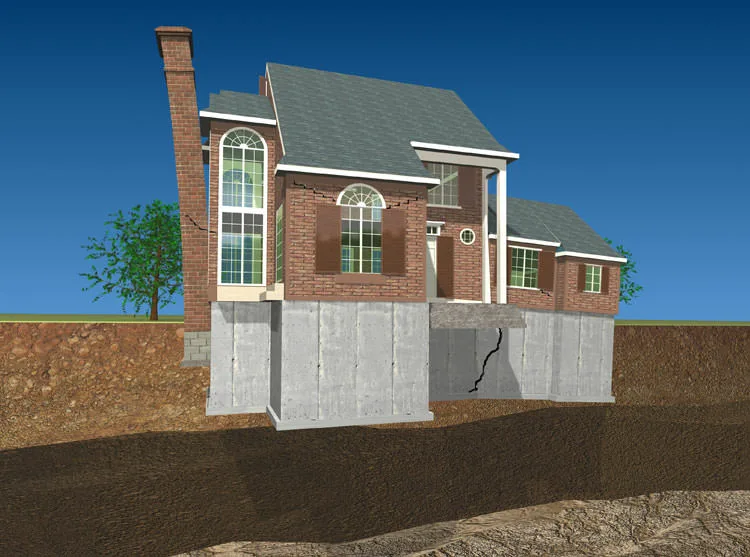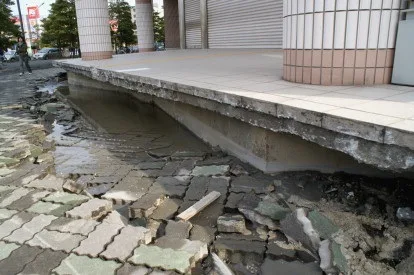Ground settlement is the gradual downward shift of the ground surface caused by the compression or displacement of underlying soil layers. It can lead to surface depressions, cracks, and misalignments in structures built above. Depending on the nature of the movement, settlement may be uniform, causing minimal disruption, or uneven, potentially leading to structural instability. The process often occurs over time, altering the ground’s load-bearing capacity and affecting the integrity of buildings, roads, and other infrastructure.
Why does it occur?
- External loads from buildings or infrastructure compress the underlying soil, causing it to settle.
- In clayey soils, water gradually escapes under pressure, leading to volume reduction over time.
- Loose or sandy soils settle quickly when subjected to weight due to particle rearrangement.
- Lowering of the water table reduces buoyant support, causing soil to collapse and settle.
- Natural processes (karst formations) or human activities (mining, tunneling) create voids, leading to surface subsidence.
- Heavy machinery, traffic, and earthquakes can disturb soil structure, causing settlement.
- Inadequate compaction during construction results in uneven ground movement over time.
Impact of Ground Settlements
- Structural Damage: Cracks, tilting, and deformation in buildings, bridges, and other structures.
- Foundation Failure: Weakening, sinking, or uneven settling of foundations, leading to instability.
- Infrastructure Disruptions: Roads, railways, and pipelines may become misaligned, affecting functionality.
- Drainage Problems: Changes in surface elevation can cause water accumulation or improper runoff.
- Service Line Damage: Settlement can rupture underground utilities like water, gas, and sewer lines.
- Uneven Terrain: Land deformation affects usability, making areas unsuitable for construction or agriculture.
- Operational Interruptions: Industrial facilities, transportation networks, and urban services may face disruptions.

Types of Ground Settlements
- Uniform Settlement: This type of settlement occurs when the ground surface or a structure settles evenly across its foundation. Since the entire area moves downward at the same rate, uniform settlement typically does not cause significant structural damage. However, it can still lead to minor elevation changes that may affect drainage patterns or require adjustments in connected infrastructure. It is more common in well-compacted soils and when loads are distributed evenly.
- Differential Settlement: When different parts of a structure settle at varying rates, it results in differential settlement. This type of settlement is particularly problematic because it can lead to cracks in walls, tilting, and structural instability. It usually occurs when the underlying soil has varying load-bearing capacities, due to differences in soil composition, moisture levels, or foundation design. Differential settlement is a leading cause of structural damage and requires careful geotechnical assessment and mitigation.
- Consolidation Settlement: This occurs when water is gradually expelled from saturated, fine-grained soils such as clay under sustained loading. As water drains out, the soil particles move closer together, causing a gradual reduction in volume. This process can take months or even years to complete, depending on the permeability of the soil. If not accounted for in design, long-term consolidation settlement can cause serious structural deformations, particularly in large buildings and infrastructure projects.
- Immediate Settlement: Also known as elastic settlement, this occurs rapidly after a load is applied, typically in loose granular soils or poorly compacted fills. The settlement happens as air voids are compressed and particles rearrange under the load. Unlike consolidation settlement, immediate settlement does not involve significant moisture loss from the soil and generally stabilizes within a short period. Proper compaction of soil before construction can help reduce the risk of excessive immediate settlement.
- Creep Settlement: This is a slow, continuous form of settlement that occurs over an extended period due to the prolonged application of stress on weak or highly compressible soils. It is commonly seen in organic soils, peat, and clayey sediments that continue to deform under sustained loads. Creep settlement can lead to progressive structural misalignment and requires long-term monitoring and intervention strategies to prevent structural failure.
- Collapse Settlement: This type of settlement occurs suddenly and is often linked to the presence of loose, porous, or water-sensitive soils. It can be triggered by factors such as excessive water infiltration, soil saturation, or removal of underlying support (such as in sinkhole formation). Collapse settlement is highly dangerous as it can cause rapid and severe structural damage without prior warning, making it a major concern in areas with unstable subsurface conditions.
- Seasonal Settlement: Changes in moisture levels due to seasonal variations can cause expansion and contraction in certain soil types, leading to periodic ground movement. Expansive clay soils, for example, swell when wet and shrink when dry, causing structures to rise and fall cyclically. This type of settlement is particularly problematic for foundations that are not designed to accommodate such fluctuations and can lead to recurring cracks and misalignments.

How to avoid Ground Settlements?
To avoid ground settlement, several preventive measures can be taken during planning, design, and construction:
- Ensure a geotechnical survey is performed before construction.
- Avoid over-excavation and ensure controlled soil removal.
- Compact in layers to achieve uniform density and prevent future settlement.
- Choose deep foundations like piles if soil conditions are weak.
- Prevent water accumulation that can weaken soil and cause subsidence.
- Distribute loads evenly to prevent excessive stress on the ground.
- Implement dewatering to maintain stable soil conditions.
- Design structures to accommodate minor ground shifts without damage.
Ground Settlement Strengthening Methods
Compaction: This method involves densifying the soil by reducing air voids through mechanical means such as rollers, vibratory compactors, or tamping. It is particularly effective for granular soils and helps increase soil strength, reduce permeability, and minimize future settlement. Proper moisture control is essential to achieve optimal compaction results.
Grouting: Grouting involves injecting cement, chemical, or polyurethane-based materials into the soil to fill voids, improve cohesion, and enhance load-bearing capacity. This method is commonly used in loose or weak soils beneath existing structures to strengthen the ground and prevent further settlement. Grouting is especially useful for mitigating differential settlement in urban areas.
Soil Stabilization: This technique enhances the strength and durability of soil by mixing it with stabilizing agents like lime, cement, fly ash, or bitumen. Stabilization alters the soil’s physical and chemical properties, making it more resistant to settlement. It is widely used in road construction and foundation improvement for weak or expansive soils.
Deep Foundations: When surface soil lacks adequate bearing capacity, deep foundations such as piles, piers, or stone columns are used to transfer loads to more stable layers. Piles are driven or drilled into the ground to reach competent soil or bedrock, preventing excessive settlement and ensuring structural stability.
Vibro Compaction: This method involves inserting a vibrating probe into granular soils to rearrange particles and increase density. Vibro compaction is highly effective in loose sandy soils and is commonly used for ground improvement in areas where heavy structures are planned. It reduces the risk of liquefaction and settlement under dynamic loads.
Preloading and Surcharging: In this method, temporary loads are applied to the soil before construction to accelerate consolidation and minimize post-construction settlement. It is commonly used in clayey soils where water needs to be expelled over time. The process can be enhanced by using vertical drains to speed up settlement.
Drainage Improvement: Excessive water in the soil can cause instability and increased settlement. Drainage systems such as sand drains, geodrains, and dewatering wells help control groundwater levels, improve soil strength, and reduce settlement risks. Proper drainage design is crucial for foundations in flood-prone or high-water-table areas.
Soil Replacement: This technique involves excavating weak or compressible soil and replacing it with well-compacted, high-strength material such as gravel or engineered fill. Soil replacement is effective for shallow foundations where weak soils cannot support structural loads. It ensures long-term stability and prevents differential settlement.
Conclusion
Effective management of ground settlement ensures the stability and longevity of structures. By adopting the right assessment methods and preventive measures, potential risks can be minimized, leading to safer and more resilient buildings and structures.

